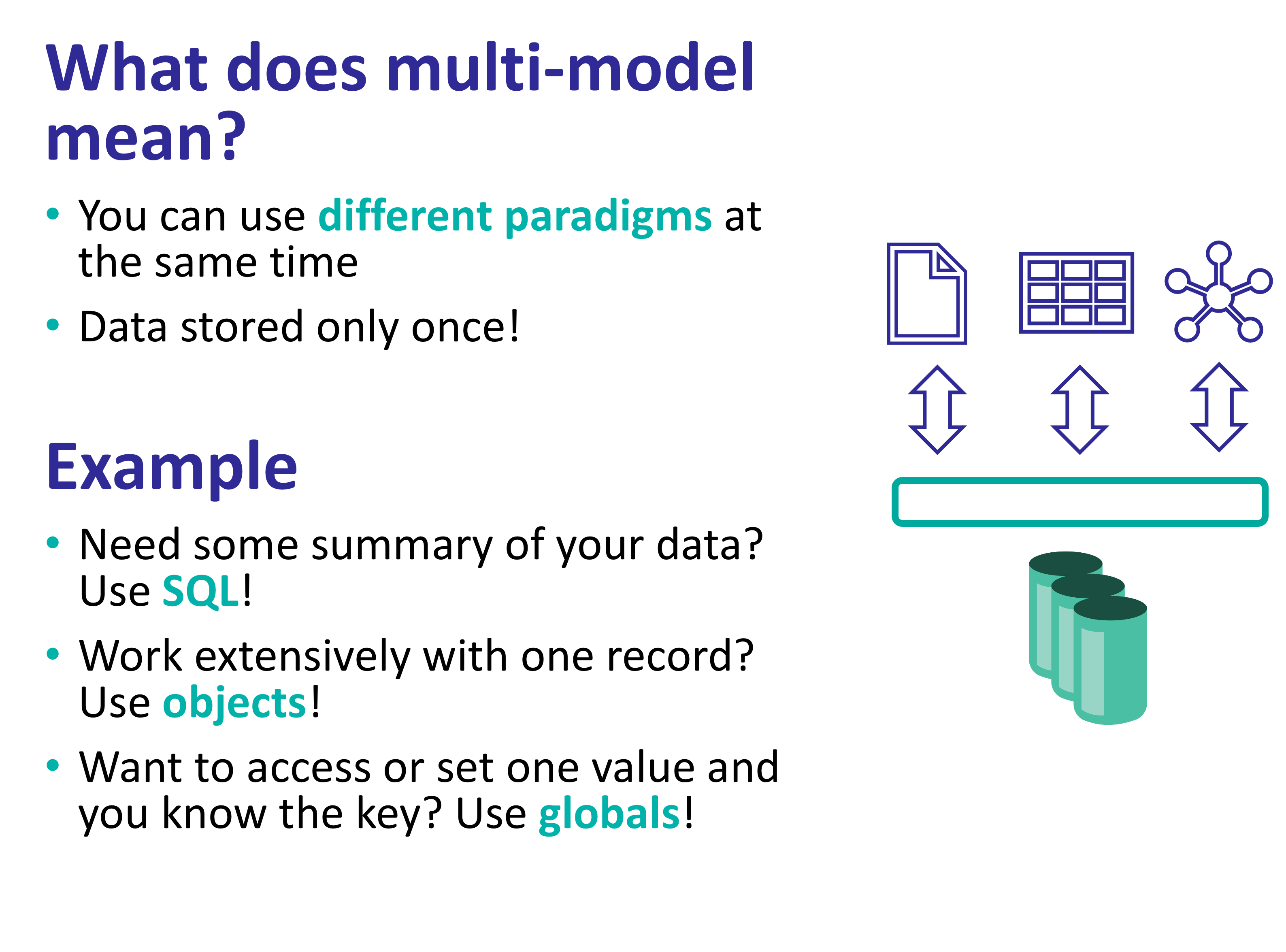Intro to basic concepts about multi-model database using InterSystems IRIS. You can find more information in InterSystems Developer Hub
- Git
- Docker (if you are using Windows, make sure you set your Docker installation to use "Linux containers").
- Docker Compose
- Visual Studio Code + InterSystems ObjectScript VSCode Extension
Build the image & run the container
docker compose build
docker compose up -dLet's create a new persistent class using VS Code:
Class game.Player Extends %Persistent [DDLAllowed]
{
Property Name As %String(MAXLEN = 255);
Property Alias As %String(MAXLEN = 50);
Property Score As %Numeric;
}This persistent class in InterSystems IRIS is also a table.
You could also create the same class using DDL / SQL:
CREATE Table sample.Player (
Name VARCHAR(255),
Alias VARCHAR(50),
Score NUMERIC
)After compiling your class in VS Code, it will generate a storage definition. This is automatically done by InterSystems IRIS to handle the persistence of the data.
Pay attention to:
- Type: generated storage type, in our case the default storage for persistent objects
- StreamLocation - global where we store streams
- IndexLocation - global for indices
- IdLocation - global where we store ID autoincremental counter
- DefaultData - storage XML element which maps global value to columns/properties
- DataLocation - global in which to store data
Class game.Player Extends %Persistent [ DdlAllowed ]
{
Property Name As %String(MAXLEN = 255);
Property Alias As %String(MAXLEN = 50);
Property Score As %Numeric;
Storage Default
{
<Data name="PlayerDefaultData">
<Value name="1">
<Value>%%CLASSNAME</Value>
</Value>
<Value name="2">
<Value>Name</Value>
</Value>
<Value name="3">
<Value>Alias</Value>
</Value>
<Value name="4">
<Value>Score</Value>
</Value>
</Data>
<DataLocation>^game.PlayerD</DataLocation>
<DefaultData>PlayerDefaultData</DefaultData>
<IdLocation>^game.PlayerD</IdLocation>
<IndexLocation>^game.PlayerI</IndexLocation>
<StreamLocation>^game.PlayerS</StreamLocation>
<Type>%Storage.Persistent</Type>
}
}DefaultData is PlayerDefaultData, it means that the global node has this structure:
- 1 - %%CLASSNAME
- 2 - Name
- 3 - Alias
- 4 - Score
So, the global should look like this:
^game.PlayerD(id) = %%CLASSNAME, Name, Alias, ScoreWe still have no data.
Open a WebTerminal session.
Let's add one object:
set p = ##class(game.Player).%New()
set p.Name = "My Player"
set p.Alias = "kraken"
set p.Score = 1377
write p.%Save()You can have a look at the data using SQL in SQL Explorer or even using an external client through JDBC like SQLTools for VS Code.
select * from game.PlayerNow, you can display the global in WebTerminal or even Global Explorer
zwrite ^game.PlayerD
^game.PlayerD=1
^game.PlayerD(1)=$lb("","My Player","kraken",1377)The expected structure %%CLASSNAME, Name, Alias, Score is set with $lb("","My Player","kraken") which corresponds to X and Y properties of our object (%%CLASSNAME is system property, ignore it).
Of course, you can also add a row via SQL:
INSERT INTO game.Player (Name, Alias, Score) VALUES ('Other player','ppp', 1100)The global will look like this:
zwrite ^game.PlayerD
^game.PlayerD=2
^game.PlayerD(1)=$lb("","My Player","kraken",1377)
^game.PlayerD(2)=$lb("","Other player","ppp",1100)You can even open the new player you have just created:
set p2 = ##class(game.Player).%OpenId(2)
zwrite p2Let's delete all the data from the table:
DELETE FROM game.PlayerOur global will look like this:
zwrite ^game.PlayerD
^game.PlayerD=2Only ID counter is left, so a new object/row would have an ID=3. Also our class and table continue to exist.
But, what happens when we run:
DROP TABLE game.PlayerIt will destroy the table, the class and delete the global:
zw ^game.PlayerDNow have a look at the class sample.Person class. Can you still find the properties and the storage definition?
Try executing the included sample method by:
do ##class(sample.Person).RunSample()Check out %JSONREFERENCE and some other options in Using the JSON Adaptor
Try the following:
After running the sample, you can create a new person:
set json = {"Name":"Other","last":"Person","BirthDate":"1983-11-03","Company":"1"}
set person = ##class(sample.Person).%JSONNew()
write person.%JSONImport(json)
write person.%Save()Try also to create a person but using a non-existent company:
set json = {"Name":"Marc","last":"MMM","BirthDate":"1993-08-03","Company":"7"}
set person = ##class(sample.Person).%JSONNew()
write person.%JSONImport(json)
do $system.Status.DisplayError(%objlasterror)